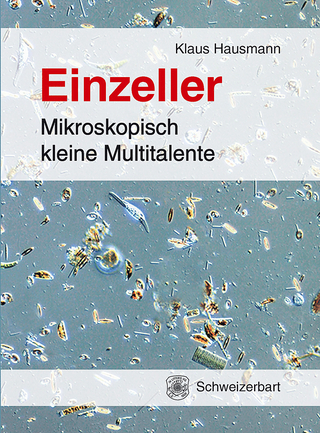
Cytogenetics
Springer-Verlag New York Inc.
978-0-387-90467-2 (ISBN)
- Titel ist leider vergriffen;
keine Neuauflage - Artikel merken
References are generously supplied to stimulate orig- inal reading on the subject and to give access to valuable sources. The detailed index is intended to be of special assistance to researchers.
I Introduction.- 1: History of Cytogenetics.- II Structure of Chromosomes.- 2: Gross Morphology of Chromosomes.- 2.1 Mitotic Metaphase Chromosomes.- 2.1.1 Total Length of Chromosomes.- 2.1.2 The Centromere.- 2.1.3 The Nucleolus Organizer Region.- 2.2 Meiotic Pachytene Chromosomes.- 2.2.1 Heterochromatin vs. Euchromatin.- 2.2.2 The Chromomeres.- 2.2.3 The Centromere.- 2.2.4 The Telomeres.- 2.2.5 The Nucleolus Organizer Region.- 2.2.6 The Knobs.- 2.3 Banding Patterns in Mitotic Metaphase Chromosomes.- 2.3.1 C-Bands.- 2.3.2 G-Bands.- 2.3.3 Q-Bands.- 2.3.4 R-Bands.- 2.3.5 Miscellaneous Bands.- 3: Fine Structure of Chromosomes.- 3.1 The Structure of DNA.- 3.2 The Structure of RNA.- 3.3 Nucleoproteins.- 3.4 Models of Chromosome Ultrastructure.- 3.4.1 The Folded Fiber Model.- 3.4.2 The Molecular Chromosome Model.- 3.4.3 The Multistranded Chromosome Model.- 3.4.4 General Chromosome Model.- 3.5 Ultrastructure of the Centromere.- III Function of Chromosomes.- 4: Function of Autosomes.- 4.1 Linkage.- 4.2 The Mechanism of Crossing Over.- 4.2.1 The Partial Chiasmatype Theory.- 4.2.2 The Belling Hypothesis.- 4.2.3 The Copy-Choice Hypothesis.- 4.2.4 The Polaron Hybrid DNA Model of Crossing Over.- 4.3 The Cytological Basis of Crossing Over.- 4.4 Locating Genes on Chromosomes and Genetic Mapping.- 5: Function of Sex-Chromosomes.- 5.1 The X-Y System.- 5.1.1 Bridges' Balance Theory.- 5.1.2 Goldschmidt's Theory.- 5.1.3 Pipkin's Theory.- 5.2 The Function of the Y Chromosome.- 5.3 Dosage Compensation.- 5.3.1 The Single Active X Hypothesis.- 5.3.2 Sex Chromatin and Drumsticks.- 5.4 Sex Linkage.- IV Movement Of Chromosomes.- 6: Chromosomes During Mitosis.- 6.1 Interphase.- 6.2 Preparation for Mitosis.- 6.2.1 The Centrosome.- 6.3 Prophase.- 6.4 Metakinesis.- 6.4.1 Chromosome Congression.- 6.4.2 Centromere Orientation.- 6.4.3 Chromosome Distribution.- 6.5 Metaphase.- 6.6 Anaphase.- 6.7 Telophase.- 7: Chromosomes During Meiosis.- 7.1 Premeiotic Interphase.- 7.2 Prophase I.- 7.2.1 Leptotene.- 7.2.2 Zygotene.- 7.2.3 Pachytene.- 7.2.4 Diplotene.- 7.2.5 Diakinesis.- 7.3 Metaphase I.- 7.4 Anaphase I.- 7.5 Telophase I and Interkinesis.- 7.6 Prophase II.- 7.7 Metaphase, Anaphase, and Telophase II.- 8: Chromosomes During Sexual Reproduction.- 8.1 Sexual Reproduction in Plants.- 8.1.1 Microsporogenesis and Spermatogenesis.- 8.1.2 Megasporogenesis and Syngamy.- 8.2 Sexual Reproduction in Animals.- 8.2.1 Spermotogenesis.- 8.2.2 Spermiogenesis.- 8.2.3 Oogenesis and Syngamy.- V Variation in Chromosome Types.- 9: Polyteny and Lampbrush Chromosomes.- 9.1 Polyteny vs. Endopolyploidy.- 9.2 Morphological Characteristics of Polytene Chromosomes.- 9.3 Puffing.- 9.4 Super Chromosomes.- 9.5 Somatic Synapsis.- 9.6 Lampbrush Chromosomes.- 10: Ring-Chromosomes, Telocentric Chromosomes, Isochromosomes, and B Chromosomes.- 10.1 Ring-Chromosomes.- 10.2 Telocentric Chromosomes.- 10.3 Isochromosomes.- 10.4 B Chromosomes.- 10.4.1 B Chromosome Structure and Genetic Constitution.- 10.4.2 Numerical Distribution, Variability, and Effects of B Chromosomes.- 10.4.3 Meiotic and Postmeiotic Behavior of B Chromosomes.- VI Variation in Chromosome Structure.- 11: Chromosome Deletions.- 11.1 Breakage-Reunion and Exchange Hypotheses.- 11.2 Spontaneous and Induced Chromosome and Chromatid Aberrations.- 11.3 Terminal Deficiencies.- 11.4 Interstitial Deletions.- 11.5 Breakage-Fusion-Bridge Cycle.- 11.6 Genetic and Cytological Tests of Deletions.- 11.7 Human Deletion Syndromes.- 12: Chromosome Duplications.- 12.1 Types of Chromosome Duplications.- 12.2 Origin of Chromosome Duplications.- 12.3 Position Effect.- 12.3.1 The Ac-Ds System.- 12.4 Other Phenotypic Effects.- 12.5 Human Chromosome Duplication Syndromes.- 13: Chromosome Inversions.- 13.1 Pericentric Inversions.- 13.2 Paracentric Inversions.- 13.3 Complex Inversions.- 13.4 Inversions as Crossover Suppressors.- 13.5 The Schultz-Redfield Effect.- 14: Chromosome Translocations.- 14.1 Types of Translocations.- 14.2 Origin of Translocations.- 14.3 Reciprocal Translocations.- 14.4 Translocations in Humans.- 14.5 Complex Heterozygosity.- 14.6 Oenothera Cytogenetics.- 14.7 Other Systems with Complex Heterozygosity ...- 14.8 Chromosome Mapping via Translocations.- VII Variation In Chromosome Number.- 15: Haploidy, Diploidy, and Polyploidy.- 15.1 Haploidy.- 15.1.1 Origin of Haploids.- 15.1.2 Meiotic Behavior of Monohaploids.- 15.1.3 Meiotic Behavior of Polyhaploids.- 15.1.4 Possible Use of Haploids.- 15.2 Diploidy.- 15.2.1 Diploidization.- 15.3 Polyploidy.- 15.3.1 Classification of Polyploidy.- 15.3.2 Autopolyploidy.- 15.3.3 Segmental Allopolyploidy.- 15.3.4 Genome Allopolyploidy.- 15.3.5 Complications with Polyploidy in Man and Animals.- 16: Aneuploidy.- 16.1 Euploidy.- 16.2 Aneuploidy.- 16.2.1 Nullisomy.- 16.2.2 Monosomy.- 16.2.3 Telosomy.- 16.2.4 Trisomy.- 16.2.5 Tetrasomy.- VIII Variation in Chromosome Function and Movement.- 17: Variation in Function of Autosomes.- 17.1 Somatic Segregation.- 17.1.1 Somatic Crossing Over.- 17.1.2 Chromosomal Chimeras.- 17.1.3 Chromosomal Mosaics.- 17.1.4 Polysomaty.- 17.1.5 Somatic Reduction.- 17.2 Variations in Mitosis.- 17.3 Variations in Meiosis.- 17.3.1 Asynapsis and Desynapsis.- 17.3.2 Variation in Crossing Over.- 17.3.3 Variation in Chromosome Size.- 17.3.4 Variation in Spindle Formation.- 17.3.5 Other Variations in Meiosis.- 17.4 Male Sterility.- 17.5 Preferential Segregation of Chromosomes.- 18: Variation in Function of Sex Chomosomes.- 18.1 Variation in Sex Ratio.- 18.2 Different Sex Chromosome Systems.- 18.3 Cytogenetics of Sciara.- 19: Apomixis and Parthenogenesis.- 19.1 Apomixis in Plants.- 19.1.1 Vegetative Reproduction.- 19.1.2 Agamospermy.- 19.2 Parthenogenesis in Animals.- 19.2.1 Experimental Induction of Parthenogenesis in Animals.- IX Extrachromosomal Inheritance.- 20: Plastids, Mitochondria, Intercellular Symbionts, and Plasmids.- 20.1 Plastids.- 20.2 Mitochondria.- 20.3 Intracellular Symbionts.- 20.3.1 The P-Particles of Paramecium.- 20.3.2 The Sigma Virus in Drosophila.- 20.3.3 The Maternal Sex-Ratio Condition in Drosophila.- 20.3.4 The Milk Factor in the Mouse (MTV).- 20.3.5 Cytoplasmic Male Sterility (CMS).- 20.4 Plasmids, Episomes and Transposable Elements.- 20.4.1 The F-Episomes.- 20.4.2 Colicinogenic Factors.- 20.4.3 Resistance Factors.- 20.4.4 Bacteriophages.- 20.4.5 IS-Elements and Transposons.- References.- General References.- Specific References.
| Erscheint lt. Verlag | 21.8.1985 |
|---|---|
| Zusatzinfo | biography |
| Verlagsort | New York, NY |
| Sprache | englisch |
| Gewicht | 1070 g |
| Themenwelt | Naturwissenschaften ► Biologie ► Zellbiologie |
| ISBN-10 | 0-387-90467-0 / 0387904670 |
| ISBN-13 | 978-0-387-90467-2 / 9780387904672 |
| Zustand | Neuware |
| Haben Sie eine Frage zum Produkt? |
aus dem Bereich


